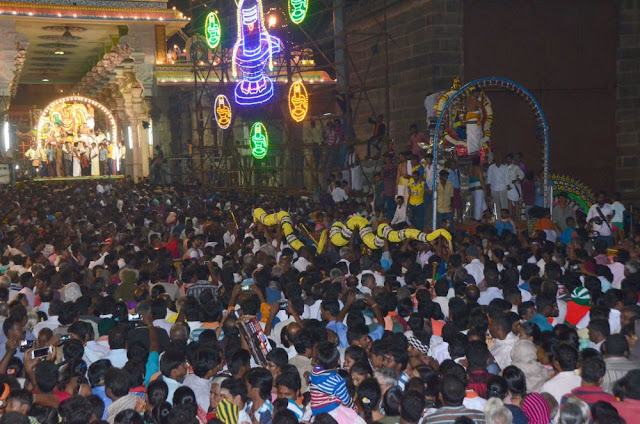Tomorrow, Friday December 9th, 2016 at 8.00 a.m., kumbhabhishekam will be performed at the Sri Isanya Math here at Tiruvannamalai. To those Arunachala devotees unfamiliar with Sri Isanya, he is regarded as of one of the great saints of Arunachala (1750-1829).
His Samadhi located at an Math dedicated to him, is opposite the Isanya Lingam (one of the Asta Lingams). To learn more about this mahatma, go to this link here.
Below is a story about the famous saint and how he helped his British devotee Ayton (who was the District Collector of the area at that time), overcome dangers in his efforts to safely attend a Deepam Festival.
Deepam: a Saint and a District Collector
The story goes thus:-
Isanya Desikar, whose math is located just outside Tiruvannamalai on the old pradakshina road, was a distinguished yogi who, like many before and after him, felt the spiritual call of Arunachala. He was born in 1750 in a small village called Rayavelur in northern Tamil Nadu. He came and settled at the foot of Arunachala only late in his life, but nevertheless, by virtue of his intense and personal relationship with Arunachaleswarar, he is regarded as one of the major saints of Arunachala.
Isanya Desikar had a western devotee, who is now recalled by the name of Ayton. He was the then District Collector for the region that extended from Tiruvannamalai to Vriddhachalam. Ayton had heard about the greatness of Isanya Desikar and approached him in the hope of getting a cure from the tuberculosis from which he had been suffering for many years.
Isanya Desikar smiled and after a brief pause spat on the ground. The moment he spat, Ayton was cured of the disease. Ayton then spoke to the holy man with both trepidation and devotion. 'Swami, I have recently acquired a large amount of land, I would like to offer your holiness as much as you need. It can be a permanent endowment in your name.'
Isanya Desikar smiled and asked tauntingly, 'Will your land yield crops even during a drought?' Then, pointing his finger towards Arunachaleswarar and Apeetakuchamba, he added, 'Here is a householder with two children and a large family. It is proper to give him any amount of land, but it is not proper to gift it to me, a sannyasin.'
Ayton took leave of him but returned on many occasions. He got into the habit of addressing him reverentially and affectionately as 'Tata', which means 'grandfather'. It is said that before he began any new project he would always meditate on Isanya Desikar and invoke his blessing by saying, 'Tata, please lead me in this work. It is your work.' At Deepam Festivals Ayton would take the lead in dragging the huge temple chariot through the streets of Tiruvannamalai. However, before moving the chariot for the first time he would pick up one of the ropes and exclaim loudly: 'Tata, you hold the rope and lead us!' The local people were all astounded that such a prominent British official should have such devotion towards a naked sannyasin.
Ayton made it a point always to attend and lead this annual festival, but one year he found himself stranded by floods on the southern side of the River Pennar just before the beginning of the festival. Knowing that he was expected to be at Arunachala to start the chariot on its journey, he called out to his mount: 'Horse, I must see Tata and I must also get the Deepam Festival started. Think of Tata and cross the river!' Without a moment's delay or hesitation, the horse leapt into the raging torrent of water and effortlessly waded to the other side. None of the other people who were stranded dared to follow for they were all convinced that it would be suicidal to enter the surging waters.
At the moment when Ayton put his faith in Tata and leapt into the water, Isanya Desikar opened his eyes after a long meditation and stretched out his hand in a southerly direction. When one of his disciples asked what he was doing, he replied, 'If someone falls into a river, should we not save him?'
Ayton arrived safely and took Isanya Desikar's blessings to start the festival. When the news of Ayton's spectacular river crossing and Isanya Desikar's role in it spread among the Deepam crowds, many of them came to the north-eastern side of the hill to see the man who had been responsible for the miracle. Several of the new visitors turned out to be mature seekers who were looking for guidance from a Guru. Isanya Desikar accepted some as disciples, had a small thatched shed built to accommodate them and gave instruction by writing a guide to liberation entitled Jnana Kattalai.
 |
| Invitation to Kumbhabhishekam |
 |
| Arunachala darshan from Isanya Ashram |
 |
| Entrance to Sri Isanya Desikar Math |
 |
| Statue of Sri Isanya Desikar |
 |
| Scaffolding in preparation to tomorrow's kumbhabhishekam |
 |
| Scaffolding erected to shrines at the Math |
 |
| Pujas and rituals being performed in Yagasalai in Math compound |
 |
| Entrance to Isanya Desikar Samadhi |
 |
| Samadhi of Isanya Desikar |









































